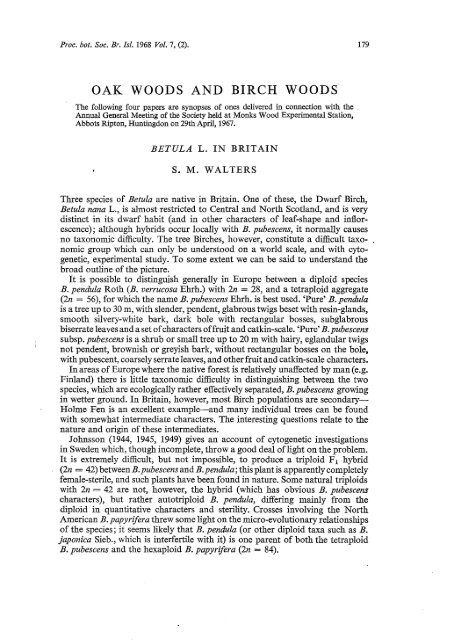pdf 98kb - BSBI Archive
pdf 98kb - BSBI Archive
pdf 98kb - BSBI Archive
You also want an ePaper? Increase the reach of your titles
YUMPU automatically turns print PDFs into web optimized ePapers that Google loves.
Proc. bot. Soc. Br. Is!. 1968 Vol. 7, (2).<br />
179<br />
OAK WOODS AND BIRCH WOODS<br />
The following four papers are synopses of ones delivered in connection with the<br />
Annual General Meeting of the Society held at Monks Wood Experimental Station,<br />
Abbots Ripton, Huntmgdon on 29th April, 1967.<br />
BETULA L. IN BRITAIN<br />
S. M. WALTERS<br />
Three species of Betula are native in Britain. One of these, the Dwarf Birch,<br />
Betula nana L., is almost restricted to Central and North Scotland, and is very<br />
distinct in its dwarf habit (and in other characters of leaf-shape and inflorescence);<br />
although hybrids occur locally with B. pubescens, it normally causes<br />
no taxonomic difficulty. The tree Birches, however, constitute a difficult taxonomic<br />
group which can only be understood on a world scale, and with cytogenetic,<br />
experimental study. To some extent we can be said to understand the<br />
broad outline of the picture.<br />
It is possible to distinguish generally in Europe between a diploid species<br />
B. pendula Roth (B. verrucosa Ehrh.) with 2n = 28, and a tetraploid aggregate<br />
(2n = 56), for which the name B. pubescens Ehrh. is best used. 'Pure' B. pendula<br />
is a tree up to 30 m, with slender, pendent, glabrous twigs beset with resin-glands,<br />
smooth silvery-white bark, dark bole with rectangular bosses, subglabrous<br />
biserrate leaves and a set of characters of fruit and catkin-scale. 'Pure' B. pubescens<br />
subsp. pubescens is a shrub or small tree up to 20 m with hairy, eglandular twigs<br />
not pendent, brownish or greyish bark, without rectangular bosses on the bole,<br />
with pubescent, coarsely serrate leaves, and other fruit and catkin-scale characters.<br />
In areas of Europe where the native forest is relatively unaffected by man (e.g.<br />
Finland) there is little taxonomic difficulty in distinguishing between the two<br />
species, which are ecologically rather effectively separated, B. pubescens growing<br />
in wetter ground. In Britain, however, most Birch populations are secondary<br />
Holme Fen is an excellent example-and many individual trees can be found<br />
with somewhat intermediate characters. The interesting questions relate to the<br />
nature and origin of these intermediates.<br />
10hnsson (1944, 1945, 1949) gives an account of cytogenetic investigations<br />
in Sweden which, though incomplete, throw a good deal of light on the problem.<br />
It is extremely difficult, but not impossible, to produce a triploid F 1 hybrid<br />
(2n = 42) between B. pubescens and B. pendula; this plant is apparently completely<br />
female-sterile, and such plants have been found in nature. Some natural triploids<br />
with 2n = 42 are not, however, the hybrid (which has obvious B. pubescens<br />
characters), but rather autotriploid B. pendula, differing mainly from the<br />
diploid in quantitative characters and sterility. Crosses involving the North<br />
American B. papyrifera threw some light on the micro-evolutionary relationships<br />
of the species; it seems likely that B. pendula (or other diploid taxa such as B.<br />
japonica Sieb., which is interfertile with it) is one parent of both the tetraploid<br />
B. pubescens and the hexaploid B. papyrifera (2n = 84).
180 S. M. WALTERS<br />
The interesting question is: what is the other likely diploid parent involved<br />
in B. pubescens, or should we look for more than one to explain some of the<br />
enormous variability in the tetraploid? On purely morphological grounds the<br />
Central and East European shrub B. humilis Schrank is an obvious candidate;<br />
but, so far as I am aware, no genetical work has yet been done involving this<br />
species.<br />
Cytological investigation of apparently hybrid populations in Britain could<br />
throw much light on the nature and extent of introgression from diploid to<br />
tetraploid, and the efficiency of isolating factors such as differing ecological<br />
preference, flowering time, etc. It is possible to get mitotic counts from young<br />
leaves (Skalinska et al1959) so that some progress can be made in determining<br />
whether individual trees are triploid or not. Any 'hybrid-index' analysis of the<br />
field populations (cf Natho 1959) suffers from the severe disadvantage that our<br />
'pure' reference-points are sUbjective ... indeed, if some introgression is possible<br />
and if the tetraploid has a polytopic origin, we may be pursuing a will-o-the-wisp<br />
in looking for 'pure' pubescens at all!<br />
REFERENCES<br />
JOHNSSON, H. (1944). Triploidy in Betula alba L. Bot. notiser, 1944, 85-89.<br />
JOHNSSON, H. (1945). Interspecifichybridization within the genus Betula. Hereditas, 31,163-176.<br />
JOHNSSON, H. (1949). Studies on birch species hybrids. 1. Betula verrucosa x B. japonica,<br />
B. verrucosa x B. papyri/era and B. pubescens x B. papyri/era. Hereditas, 35, 115-135.<br />
NATHO, G. (1959). Variationsbreite und Bastardbildung bei mitteleuropiiischen Birkensippen.<br />
Feddes Repert., 61, 211-273.<br />
SKAliNSKA, M., et. al. (1959). Further studies in chromosome numbers of Polish Angiosperms<br />
(Dicotyledons). Acta Soc. Bot. Pol., 28, 487-488.
















